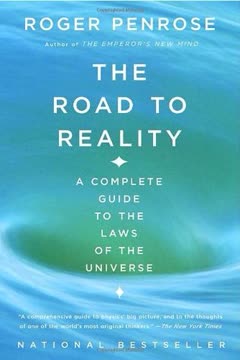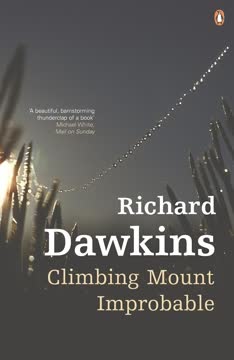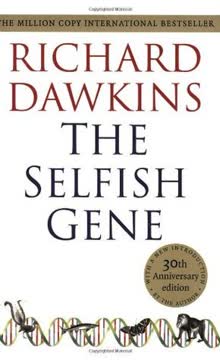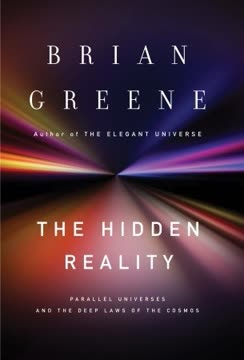Key Takeaways
1. The Earth's history is incomprehensibly vast, with life emerging early
"If you imagine the 4,500-billion-odd years of Earth's history compressed into a normal earthly day, then life begins very early, about 4 A.M., with the rise of the first simple, single-celled organisms, but then advances no further for the next sixteen hours."
Earth's timeline is staggering. Our planet formed about 4.5 billion years ago, and life emerged surprisingly early, around 3.8 billion years ago. This early appearance of life suggests that, given the right conditions, life may be a relatively common occurrence in the universe.
Life's evolution was slow at first. For billions of years, life remained microscopic and simple. Complex multicellular life only appeared relatively recently in Earth's history, with the Cambrian explosion occurring about 541 million years ago. This sudden burst of diversity laid the foundation for all modern animal life.
Key events in Earth's history:
- 4.5 billion years ago: Earth forms
- 3.8 billion years ago: First life appears
- 541 million years ago: Cambrian explosion
- 65 million years ago: Dinosaur extinction
- 200,000 years ago: Modern humans emerge
2. Cells are the fundamental units of life, intricate and astonishingly complex
"You possess some few hundred different types of cell, according to the Belgian biochemist Christian de Duve, and they vary enormously in size and shape, from nerve cells whose filaments can stretch to several feet to tiny, disc-shaped red blood cells to the rod-shaped photocells that help to give us vision."
Cells are marvels of engineering. Each cell is a bustling metropolis of activity, with countless molecules and organelles working in harmony to maintain life. The complexity of a single cell rivals that of a modern city, with intricate systems for energy production, waste management, and information processing.
Cellular diversity is astounding. From neurons that can stretch several feet to tiny red blood cells, the human body contains an incredible variety of specialized cells. Each type is exquisitely adapted to its function, whether it's conducting electrical signals, transporting oxygen, or detecting light.
Key cellular components:
- Nucleus: houses genetic material
- Mitochondria: powerhouses of the cell
- Endoplasmic reticulum: protein and lipid factory
- Golgi apparatus: packaging and distribution center
- Cell membrane: selective barrier and communication interface
3. Evolution through natural selection explains the diversity of life
"Darwin's time aboard HMS Beagle, from 1831 to 1836, was obviously the formative experience of his life, but also one of the most trying."
Darwin's journey sparked a revolution. Charles Darwin's voyage on the HMS Beagle provided him with the observations and experiences that would eventually lead to his theory of evolution by natural selection. This groundbreaking idea explains how species change over time, adapting to their environments.
Natural selection is elegantly simple. The core of Darwin's theory is that organisms with beneficial traits are more likely to survive and reproduce, passing those traits to their offspring. Over time, this process leads to the evolution of new species and the incredible diversity of life we see today.
Key principles of natural selection:
- Variation: Individuals within a species differ
- Inheritance: Traits can be passed to offspring
- Competition: Not all individuals survive and reproduce
- Survival of the fittest: Those best adapted to their environment thrive
- Gradual change: Species evolve over many generations
4. Humans are a product of chance and cosmic accidents
"We are astoundingly, sumptuously, radiantly ignorant of life beneath the seas."
Our existence is improbable. The series of events that led to human evolution was highly unlikely. From the formation of Earth to the extinction of the dinosaurs, countless cosmic accidents and chance occurrences were necessary for our species to emerge.
We know little about our own planet. Despite our advanced technology, we have explored only a tiny fraction of our oceans and the life they contain. This ignorance extends to many aspects of our world, from the depths of the Earth to the far reaches of the universe.
Factors contributing to human existence:
- Earth's position in the "habitable zone" of our solar system
- The Moon's stabilizing effect on Earth's axis
- The extinction of dinosaurs, allowing mammals to diversify
- The evolution of bipedalism and large brains in our ancestors
- The development of complex language and culture
5. The universe is largely unknown, with dark matter dominating
"To read even an elementary guide to particle physics nowadays you must now find your way through lexical thickets such as this: 'The charged pion and antipion decay respectively into a muon plus antineutrino and an antimuon plus neutrino with an average lifetime of 2.603 x 10-8 seconds, the neutral pion decays into two photons with an average lifetime of about 0.8 x 10-16 seconds, and the muon and antimuon decay respectively into...'"
The universe is mostly mysterious. Despite centuries of scientific progress, we still don't understand what makes up most of the universe. Dark matter and dark energy, which we cannot directly observe, comprise about 95% of the cosmos.
Particle physics is mind-bendingly complex. The study of the fundamental particles that make up matter has revealed a bizarre world of quarks, leptons, and bosons. This subatomic realm behaves in ways that defy our everyday intuitions about how the world works.
Key concepts in modern physics:
- Standard Model: describes known elementary particles and forces
- Quantum mechanics: explains behavior of matter at smallest scales
- General relativity: describes gravity and the structure of spacetime
- String theory: attempts to unify quantum mechanics and general relativity
- Multiverse hypothesis: suggests our universe may be one of many
6. Extinction events have shaped life's history dramatically
"The Permian extinction of about 245 million years ago, which raised the curtain on the long age of the dinosaurs. In the Permian, at least 95 percent of animals known from the fossil record check out, never to return."
Mass extinctions reset the evolutionary clock. Throughout Earth's history, several major extinction events have dramatically altered the course of life's evolution. These events, caused by various factors such as asteroid impacts or massive volcanic eruptions, have wiped out huge percentages of species.
Extinctions create opportunities. While devastating for existing species, mass extinctions also open up ecological niches for surviving organisms to evolve and diversify. The extinction of the dinosaurs, for example, allowed mammals to flourish and eventually give rise to humans.
Major extinction events:
- End-Ordovician (444 million years ago): 86% of species lost
- Late Devonian (375 million years ago): 75% of species lost
- End-Permian (251 million years ago): 96% of species lost
- End-Triassic (200 million years ago): 80% of species lost
- End-Cretaceous (66 million years ago): 76% of species lost
7. Scientific discoveries often face resistance and controversy
"Darwin kept his theory to himself because he well knew the storm it would cause."
New ideas challenge existing beliefs. Throughout history, groundbreaking scientific discoveries have often been met with skepticism, resistance, and even hostility. This is particularly true when new theories challenge deeply held beliefs or overturn long-established paradigms.
Scientific progress is not linear. The path to scientific understanding is often fraught with controversy, false starts, and competing theories. It can take years or even decades for new ideas to gain acceptance within the scientific community and broader society.
Examples of controversial scientific ideas:
- Heliocentrism: Earth orbits the Sun (Copernicus, Galileo)
- Plate tectonics: continents move (Wegener)
- Big Bang theory: universe had a beginning (Lemaître)
- Quantum mechanics: particles behave probabilistically (Bohr, Heisenberg)
- Climate change: human activities are warming the planet (multiple scientists)
8. Human impact on Earth is significant and potentially catastrophic
"To get around the problems of fossil distributions, they posited ancient 'land bridges' wherever they were needed."
We are altering the planet at an unprecedented rate. Human activities, from deforestation to greenhouse gas emissions, are causing rapid changes to Earth's climate, ecosystems, and biodiversity. These changes are occurring at a pace that may be too fast for many species to adapt.
Our understanding of Earth's systems is still limited. Despite our significant impact on the planet, we still have much to learn about how Earth's complex systems interact. This knowledge gap makes it challenging to predict and mitigate the long-term consequences of our actions.
Major human impacts on Earth:
- Climate change due to greenhouse gas emissions
- Deforestation and habitat destruction
- Ocean acidification and plastic pollution
- Overfishing and agricultural intensification
- Introduction of invasive species
9. Life exists in extreme environments, defying our expectations
"Bacteria may not build cities or have interesting social lives, but they will be here when the Sun explodes. This is their planet, and we are on it only because they allow us to be."
Life is incredibly resilient. Organisms have been found thriving in environments we once thought were too hostile for life, from deep-sea hydrothermal vents to highly acidic hot springs. These extremophiles demonstrate the remarkable adaptability of life.
Microorganisms dominate Earth's biomass. While large, complex organisms like humans tend to capture our attention, the vast majority of life on Earth consists of microscopic organisms. Bacteria, in particular, are found in virtually every environment on the planet and play crucial roles in global biogeochemical cycles.
Examples of extreme environments where life thrives:
- Deep-sea hydrothermal vents (temperatures up to 400°C)
- Antarctic Dry Valleys (extremely cold and dry)
- Dallol, Ethiopia (highly acidic hot springs)
- Stratosphere (high radiation, low pressure)
- Nuclear reactor cooling pools
10. The microscopic world is vast, diverse, and largely unexplored
"The average distance between stars out there is 20 million million miles. Even at speeds approaching those of light, these are fantastically challenging distances for any traveling individual."
Most life is invisible to the naked eye. The majority of Earth's biodiversity exists at the microscopic level, in the form of bacteria, archaea, fungi, and other microorganisms. This hidden world is crucial to the functioning of all ecosystems and to life as we know it.
We have only scratched the surface. Despite centuries of scientific exploration, we have identified and described only a small fraction of Earth's species. The vast majority of microorganisms remain unknown to science, representing a frontier of discovery with immense potential for new insights and applications.
Estimates of global biodiversity:
- Total number of species: 8.7 million (±1.3 million)
- Described species: ~1.2 million
- Undescribed species: ~7.5 million
- Percentage of undescribed species: ~86%
- Majority of undescribed species are likely microorganisms
Last updated:
FAQ
What's A Short History of Nearly Everything about?
- Exploration of science: The book delves into a wide range of scientific topics, from the Big Bang to the evolution of life, making complex ideas accessible to the general reader.
- Historical focus: It chronicles the history of scientific discovery, highlighting key figures like Newton, Darwin, and Einstein, and their contributions to our understanding of the world.
- Interconnectedness of disciplines: Bryson illustrates how different scientific fields are interconnected, showing that understanding one area often requires knowledge of others.
Why should I read A Short History of Nearly Everything?
- Engaging writing style: Bill Bryson's witty and conversational tone makes the book enjoyable, even for those not typically interested in science.
- Comprehensive overview: The book covers a broad range of scientific topics, making it a great introduction for anyone looking to learn more about science.
- Inspiration for curiosity: Bryson's enthusiasm for science is infectious, encouraging readers to appreciate the wonders of the natural world.
What are the key takeaways of A Short History of Nearly Everything?
- Improbability of life: Bryson emphasizes the extraordinary odds against life existing on Earth, highlighting its fragility and rarity.
- Collaborative nature of science: The book illustrates how scientific progress relies on the contributions of many individuals over time.
- Understanding the universe: Readers gain insight into the vastness and complexity of the universe, including concepts like the Big Bang.
What are the best quotes from A Short History of Nearly Everything and what do they mean?
- "The only thing special about the atoms that make you is that they make you.": This underscores the miraculous nature of existence, as common elements are uniquely arranged to create life.
- "The universe is not only queerer than we suppose; it is queerer than we can suppose.": This suggests that the complexities of the universe are beyond human comprehension, inviting readers to embrace scientific mysteries.
- "Atoms are fickle and their time of devotion is fleeting.": Bryson highlights the transient nature of life, reflecting on the impermanence of existence.
How does Bill Bryson explain the formation of the universe in A Short History of Nearly Everything?
- Big Bang theory: Bryson describes the Big Bang as the universe's expansion from a singularity, producing gravity and fundamental forces.
- Rapid expansion: He explains the dramatic inflation of the universe in its first moments, setting the stage for the formation of stars and galaxies.
- Cosmic background radiation: Bryson discusses the discovery of cosmic background radiation, which supports the Big Bang theory and helps understand the universe's origins.
How does A Short History of Nearly Everything address the concept of evolution?
- Darwin's theory: Bryson discusses Charles Darwin's contributions, particularly natural selection, and how it revolutionized biology.
- Improbability of life: He emphasizes the extraordinary odds against specific forms of life existing, highlighting the fragility of life.
- Interconnectedness of species: Bryson illustrates how all living organisms are connected through evolutionary history, fostering appreciation for biodiversity.
What role do atoms play in A Short History of Nearly Everything?
- Basic building blocks: Bryson emphasizes that all things are made of atoms, highlighting their fundamental role in matter's composition.
- Durability and abundance: He notes that atoms are incredibly durable and numerous, with each person containing atoms that have existed for billions of years.
- Complexity of atomic structure: Bryson explains the structure of atoms, including protons, neutrons, and electrons, and how they interact.
What does Bill Bryson say about the history of Earth in A Short History of Nearly Everything?
- Age of the Earth: Bryson presents Clair Patterson's work in determining the Earth's age as approximately 4.55 billion years.
- Geological processes: He describes processes like plate tectonics and erosion that have shaped the planet over billions of years.
- Impact events: Bryson discusses the significance of impact events, such as the asteroid that likely contributed to the extinction of the dinosaurs.
How does A Short History of Nearly Everything explain the development of scientific thought?
- Historical context: Bryson provides an overview of key scientific figures and their contributions, illustrating the evolution of scientific thought.
- Challenges and breakthroughs: The book chronicles the challenges faced by scientists and the breakthroughs that have shaped our understanding.
- Interdisciplinary connections: Bryson shows how different scientific disciplines are interconnected, helping readers appreciate the complexity of scientific inquiry.
What are some of the major scientific discoveries discussed in A Short History of Nearly Everything?
- Discovery of radioactivity: Bryson discusses the work of scientists like Marie Curie in uncovering radioactivity's properties.
- The periodic table: He highlights Dmitri Mendeleyev's creation of the periodic table, fundamental to modern chemistry.
- The theory of evolution: Bryson emphasizes Darwin's theory of evolution by natural selection, a cornerstone of biological sciences.
How does Bill Bryson portray the relationship between science and society in A Short History of Nearly Everything?
- Science as a collaborative effort: Bryson emphasizes that scientific progress relies on the contributions of many individuals over time.
- Public perception of science: He discusses how public understanding can be influenced by cultural factors, sometimes leading to misconceptions.
- Impact of scientific discoveries: The book illustrates how discoveries have shaped society and influenced our understanding of the world.
How does A Short History of Nearly Everything conclude regarding humanity's future?
- Responsibility for the planet: Bryson emphasizes the need for humans to take care of the Earth and its ecosystems.
- Uncertainty of existence: The book reflects on life's fragility and the unpredictability of the future, urging appreciation of the present.
- Hope for progress: Despite challenges, Bryson expresses optimism about humanity's potential to learn and grow, encouraging curiosity and exploration.
Review Summary
A Short History of Nearly Everything receives widespread praise for its engaging and accessible approach to science. Readers appreciate Bryson's humor and ability to explain complex topics. Many find the book enlightening, covering a vast range of scientific fields. Some criticize factual errors or oversimplification, but most agree it's an entertaining and informative read. Readers particularly enjoy learning about lesser-known scientists and their contributions. The book is seen as a great introduction to science for non-specialists.
Similar Books










Download PDF
Download EPUB
.epub digital book format is ideal for reading ebooks on phones, tablets, and e-readers.










